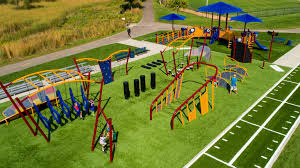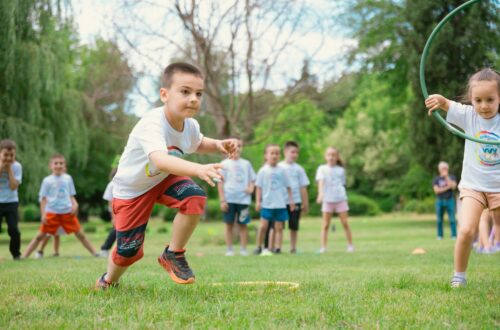If you’re looking for a fun and engaging way to keep everyone active at home, constructing a DIY obstacle course is a fantastic idea. It’s an enjoyable way to enhance agility, balance, strength, and, most importantly, create lasting family memories. Whether you’re setting it up for your kids, a friendly competition amongst adults, or even for your family’s furry friends, a homemade obstacle course offers endless entertainment. The best part? You don’t need to be a professional designer or have expensive equipment to create a challenging and exciting course. Let’s dive into how you can create your own DIY obstacle course at home!
For a full guide on creating an obstacle course, check out this article.
Step 1: Choose the Right Space
The first step in designing your DIY obstacle course is selecting an appropriate location. You’ll need enough space to arrange the obstacles and allow participants to move freely. If you’re working indoors, you can use the living room, hallway, or basement. Make sure the space is safe, clear of obstacles like furniture that could be hazardous, and large enough to fit the entire course.
If you’re outdoors, your backyard or a nearby park is ideal. Outdoor courses provide more room to get creative with physical challenges, and you can take advantage of natural elements like trees, garden beds, and open space. Whether inside or outside, it’s essential to choose a safe and secure area where everyone can enjoy the fun without the risk of injury.
Step 2: Plan Your Obstacles
When designing your obstacle course, think about the skills you want to challenge. You can focus on various aspects like balance, agility, strength, and coordination. Here are some ideas for obstacles you can create using simple household items:
- Crawling Under or Through: Use chairs, tables, or even a row of broomsticks to create tunnels that participants must crawl under or through. You can use blankets or sheets to add a more challenging element.
- Balance Beams: Lay down a long piece of wood or even a sturdy plank on the ground to create a balance beam. The objective is for participants to walk across it without falling off.
- Jumping Challenges: Use tape or ropes to mark spots that participants must jump over or hop between. You can also use hula hoops or a row of pillows for jumping between.
- Tire Course: If you have access to old tires, line them up in a zig-zag pattern or stack them for participants to jump into and out of, or step through.
- Sprints or Running Laps: Incorporate running sections to test speed. Set up cones or markers to create a short sprint course or running lap.
- Climbing or Lifting: If you have sturdy furniture like a small step stool or ladder, you can create a mini climbing challenge. Participants can climb or step over these obstacles.
- Hula Hoop Toss: Place a few hula hoops on the ground and challenge participants to toss a beanbag or ball into each hoop, adding a level of precision to the course.
Make sure to vary the difficulty levels depending on the age or fitness level of participants. For kids, include fun, less challenging obstacles like jumping over a line of socks or balancing a balloon while walking. For adults, increase the difficulty by adding higher or more intricate obstacles, or even a timed challenge for extra excitement.
Step 3: Gather Your Materials
Once you have your obstacle ideas, gather the materials you’ll need. You don’t have to purchase fancy equipment; the beauty of a DIY obstacle course is that you can use everyday items. Here’s a list of things you may need:
- Chairs, tables, or stools for crawling under or climbing
- Ropes, broomsticks, or planks for balance beams
- Cones, markers, or tape for outlining the course
- Old tires or large containers for stepping through
- Pillows or blankets for cushioning or jumping over
- Balls, hula hoops, and beanbags for tossing challenges
Don’t forget to have a timer on hand if you plan to race or time participants. You may also want to use a stopwatch or phone app to track time, or just to add a sense of competition to the event.
Step 4: Set Up Your Course
Now comes the fun part—setting up your course! Start by marking the starting line and the finish line. You can use cones or tape to indicate where the course begins and ends. Arrange your obstacles in a sequence, making sure there’s enough space between them for participants to move through comfortably. Think about how each obstacle flows into the next; the course should feel like a continuous challenge rather than individual obstacles spread out randomly.
For example, you could have participants crawl under a row of chairs, then jump over a row of pillows, balance across a beam, sprint to the next obstacle, and finish with a hula hoop toss. Use markers or tape to guide participants along the correct path and keep the course organized.
Step 5: Make It Fun and Safe
Safety is key when designing your DIY obstacle course. Ensure that obstacles are stable and won’t tip over or cause injury. For example, if you’re using furniture, make sure it’s sturdy and won’t shift when weight is placed on it. Additionally, use soft materials like cushions or blankets to create a safe landing area for jumping or falling.
To add to the fun, consider adding a theme to your obstacle course, like a jungle adventure, spy mission, or superhero training. You can even include “pit stops” along the way where participants can take a short break, hydrate, or complete mini challenges.
For added excitement, you can introduce a timed competition or offer small rewards to participants who complete the course in the fastest time or with the most accuracy. You can also challenge participants to repeat the course, improving their time with each try.
Step 6: Get Moving and Have Fun!
Once everything is set up, it’s time to get moving! Whether you’re challenging your kids to complete the course, racing against each other in a friendly adult competition, or seeing how your pet navigates through the obstacles, a DIY obstacle course brings out the fun in everyone.
Encourage everyone to try different approaches to each obstacle, and celebrate each success, no matter how big or small. Remember, the goal is to have fun and enjoy spending time together as a family.
For more tips and ideas on creating a DIY obstacle course at home, be sure to read this article.


